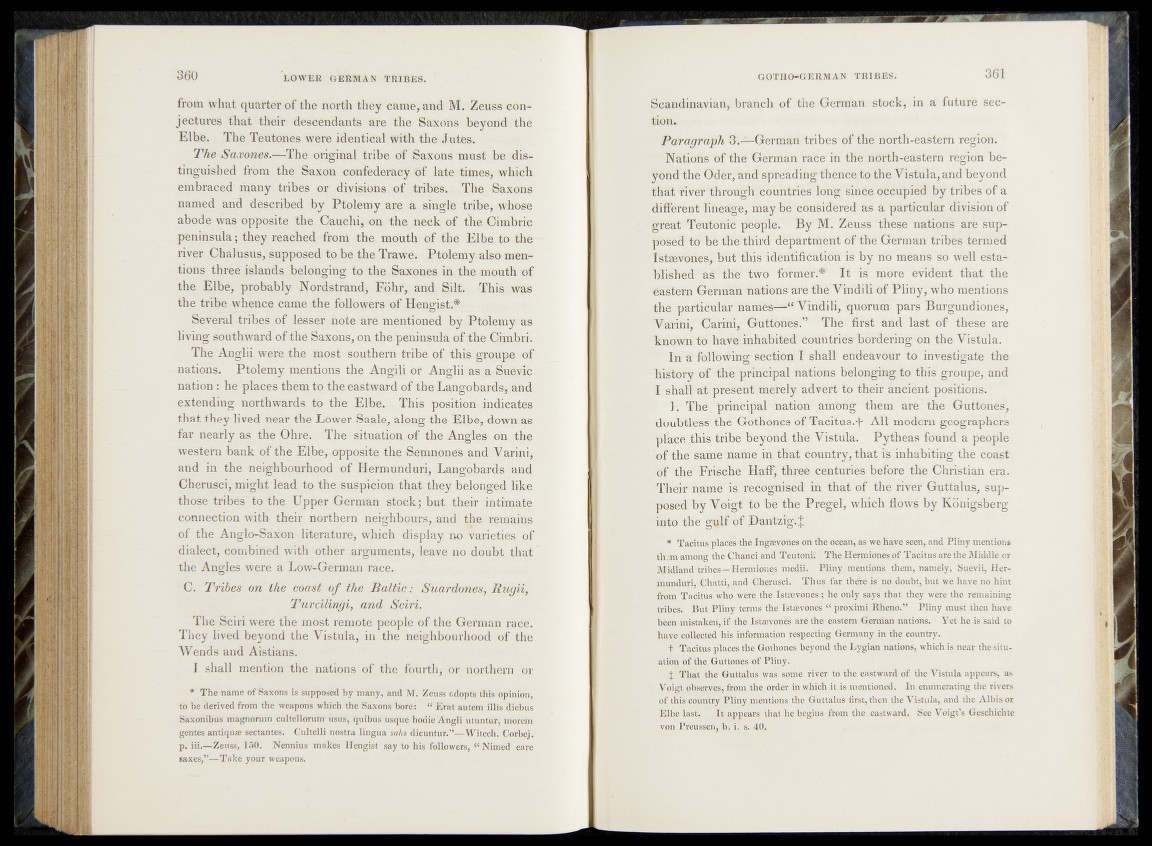
from what quarter of the north they came, and M. Zeuss conjectures
that their descendants are the Saxons beyond the
Elbe. The Teutones were identical with the Jules.
The Saxones.—The original tribe of Saxons must be distinguished
from the Saxon confederacy of late times, which
embraced many tribes or divisions of tribes. The Saxons
named and described by Ptolemy are a single tribe, whose
abode was opposite the Cauchi, on the neck of the Cimbric
peninsula ; they reached from the mouth of the Elbe to the
river Chalusus, supposed to be the Trawe. Ptolemy also mentions
three islands belonging to the Saxones in ^the mouth of
the Elbe, probably Nordstrand, Fdhiy and Silt. This was
the tribe whence came the followers of Hengist.*
Several tribes of lesser note are mentioned by Ptolemy as
living southward of the Saxons, on the peninsula of the Cimbri.
The Anglii were the most southern tribe of this groupe of
nations. Ptolemy mentions the Angili of Anglji as a Slueyi'c
nation: he places them to the eastward of the Langobards5,and
extending northwards to the Elbe. This position indicates
that they lived near the Lower Saale, along the Elbe, down as
far nearly as the Ohre. The situation of the Angles on the
western bank of the Elbe, opposite the Semnones and Varini,
and in the neighbourhood of Hermunduri, Laiigobards and
Gherusci, might lead to the suspicion that they belonged like
those tribes to the Upper German stock; but- -their intimate
connection with their northern neighbours, „and the remains
of the Anglo-Saxon literature, which display no varieties of
dialect, combined with other arguments, leave no doubt that
the Angles were a Low-German race.
C. Tribes on ike coast o f the B a ltic : Suardones, Rugii,
Turcilingi, and Sczri.
The Sciri were the most remote people of the German race.
They lived beyond the Vistula, in the neighbourhood of the
Wends and Aistians.
I shall mention the nations of the fourth, or northern or
* The name of Saxons is supposed by many, and M. Zeuss adopts this Opinion,
to he derived from the weapons which the Saxons bores “ Erat autem illis diebus
Saxonibus magnorum cultellorum usus, quibus usque hodie Angli utuntur, morem
gentes antiquae sectantes. Cultelli nostra lingua sa h s dieuntur.”—Witech. Corbej.
p. iii.—Zeuss, 150. Nennius makes Hengist say to his followers, “ Nimed eare
saxes,”—Take your weapons.
Scandinavian, branch of the German stock, in a future section*
Paragraph 3!^Germ;an tribes öf thé north-eastern region.
H Nations of the German race in the north-eastern region be-
ychd the Oder, and-Spreading thence to the Vistula, and beyond
that river through ëöuütries long since occupied by tribes of a
different lineage, may be considered as a particular division of
great Teutonic pèôple. By M. Zeuss these nations are supposed
to be the third dfepärtment of the German tribes termed
Istævones, brit this identification is by no means so well established
às the two former.* I t is more evident that thé
eastern German nations are the Vmdili of Pliny, who mentions
the particular names—“ Vindili, quorum pars BufgundiOhes,
Varirii; Carihi, Guttones.” The first and last of thèse are
known to havé inhabited countries bordering'on the Vistula.
In a following section I shall endeavour to investigate the
' history 'o fJ the principal nations belonging to this groupe, and
I Shall at ptèsènt merely advert to their ancient positions!'
1 1. The 'principal nation among them arè the Guttones,
pfôdbtfesè the"Gothones of Tacitus.^ All modern geographers
placethis tribe beyond the Vistula. Pytheas found a people
fof'the Same name in that country, that is inhabiting the coast
of the Frische IIaff, three centuries before the Christian era.
ITreir name is recognised in that of the river Guttalus, supposed
by Voigt to be the Pregel, which flows by Königsberg
into the gylf'of Dantzig;^
* Tacitus places the Ingævones on the ocean, as we have seen, and Pliny mentions
' them «mnng the Chauci and Teutoni. The Hermiones of Tacitus are the Middle or
Midland tribes—Hermiones medii. Pliny mentions, them, namely, Suevii, Her-
mupduri, Chatti, and Cherusci. Thus far there is no doubt, but we have no hint
from Tacitus who were the Istævones ; he only says that they were the remaining
tribes. But Pliny terms the Istævones “ proximi Bheno.” Pliny must then have
been mistaken, if the Istævones are the eastern German nations. Yet he is said to
have collected his information respecting Germany in the country.
t Tacitus places the Gothones beyond the Lygian nations, which is near the situation
of the Guttones of Pliny.
% That the Guttalus was some river to the eastward of the Vistula appears, as
’ Voigt observes, from the order in which it is mentioned. In enumerating the rivers
of this country Pliny mentions the Guttalus first, then the Vistula, and the Albis or
Elbe last. It appears that he begins from the eastward. See Voigt’s Geschichte
; yon Preussen, b. 1, s. 40.